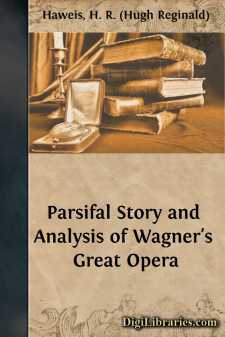Categories
- Antiques & Collectibles 13
- Architecture 36
- Art 48
- Bibles 22
- Biography & Autobiography 813
- Body, Mind & Spirit 142
- Business & Economics 28
- Children's Books 17
- Children's Fiction 14
- Computers 4
- Cooking 94
- Crafts & Hobbies 4
- Drama 346
- Education 46
- Family & Relationships 57
- Fiction 11829
- Games 19
- Gardening 17
- Health & Fitness 34
- History 1377
- House & Home 1
- Humor 147
- Juvenile Fiction 1873
- Juvenile Nonfiction 202
- Language Arts & Disciplines 88
- Law 16
- Literary Collections 686
- Literary Criticism 179
- Mathematics 13
- Medical 41
- Music 40
- Nature 179
- Non-Classifiable 1768
- Performing Arts 7
- Periodicals 1453
- Philosophy 64
- Photography 2
- Poetry 896
- Political Science 203
- Psychology 42
- Reference 154
- Religion 513
- Science 126
- Self-Help 84
- Social Science 81
- Sports & Recreation 34
- Study Aids 3
- Technology & Engineering 59
- Transportation 23
- Travel 463
- True Crime 29
Parsifal Story and Analysis of Wagner's Great Opera
Categories:
Description:
Excerpt
WAHNFRIED
I visited Bayreuth on the 24th of July, 1883, and attended two crowded performances of Wagner's last work, Parsifal. In the morning I went into the beautiful gardens of the Neue Schloss. On either side of a lake, upon which float a couple of swans and innumerable water-lilies, the long parklike avenue of trees are vocal with wild doves, and the robin is heard in the adjoining thickets. At my approach the sweet song ceases abruptly, and the startled bird flies out, scattering the pale petals of the wild roses upon my path. I follow a stream of people on foot, as they move down the left-hand avenue in the garden of the Neue Schloss, which adjoins Wagner's own grounds.
Some are going—some are coming. Presently I see an opening in the bushes on my left; the path leads me to a clump of evergreens. I follow it, and come suddenly on the great composer's grave. All about the green square mound the trees are thick—laurel, fir, and yew. The shades fall funereally across the immense gray granite slab; but over the dark foliage the sky is bright blue, and straight in front of me, above the low bushes, I can see the bow-windows of the dead master's study—where I spent with him one delightful evening in 1876.
I can see, too, the jet of water that he loved playing high above the hedge of evergreen. It lulls me with its sound. "Wahnfried! Wahnfried!" it seems to murmur. It was the word written above the master's house—the word he most loved—the word his tireless spirit most believed in. How shall I render it? "Dream-life! dream-life! Earth's illusion of joy!"
Great spirit! thy dream-life here is past, and, face to face with truth, "rapt from the fickle and the frail," for thee the illusion has vanished! Mayest thou also know the fulness of joy in the unbroken and serene activities of the eternal Reality!
I visited the grave twice. There is nothing written on the granite slab. There were never present less than twenty persons, and a constant stream of pilgrims kept coming and going.
One gentle token of the master's pitiful and tender regard for the faithful dumb animals he so loved lies but a few feet off in the same garden, and not far from his own grave.
Upon a mossy bank, surrounded with evergreens, is a small marble slab, with this inscription to his favorite dog:
"Here lies in peace 'Wahnfried's' faithful watcher and friend—the good and beautiful Mark" (der gute, schöne Mark)!
I returned, too, to Wagner's tomb, plucked a branch of the fir-tree that waved above it, and went back to my room to prepare myself by reading and meditation for the great religious drama which I was to witness at four o'clock in the afternoon—Wagner's latest and highest inspiration—the story of the sacred brotherhood, the knights of San Graal—Parsifal!
The blood of God!—mystic symbol of divine life—"for the blood is the life thereof." That is the key-note of Parsifal, the Knight of the Sangrail. Wine is the ready symbolical vehicle—the material link between the divine and the human life. In the old religions, that heightened consciousness, that intensity of feeling produced by stimulant, was thought to be the very entering in of the "god"—the union of the divine and human spirit; and in the Eleusinian mysteries, the "sesame," the bread of Demeter, the earth mother, and the "kykeon," or wine of Dionysos, the vine god, were thus sacramental.
The passionate desire to approach and mingle with Deity is the one mystic bond common to all religions in all lands....


